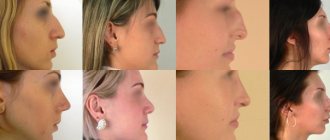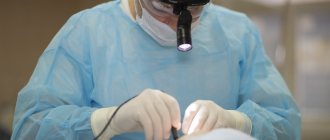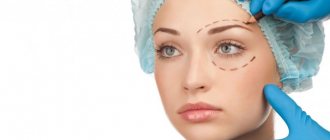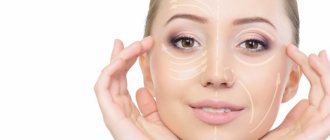Why are plastic surgery and aesthetic medicine so in demand today? Everything is very simple. It's no secret that beautiful people have many more advantages in their personal and professional lives than less attractive people. Alas, just a few decades ago, in terms of appearance, we all had to be content with what nature gave.
Modern plastic surgery has allowed people to equalize the odds and decide their own destinies. The latest technologies and techniques, coupled with the art of doctors, have given us the opportunity to obtain the desired changes in appearance quickly and without harm to health.
Time, the most widely read magazine in the United States, recently proclaimed plastic surgery to be the new makeup, thereby emphasizing the degree of routine that plastic surgery has achieved today.
And yet, although cosmetic operations have ceased to be something exotic and accessible only to celestials, it is important to remember one nuance. An excellent result of plastic surgery depends, first of all, on the professional skill, talent and aesthetic sense of the doctor. We are proud to announce that these are the kind of plastic surgeons who work at the MedicCity clinic!
Patient satisfaction is one of the main criteria for the success of aesthetic surgery and, in fact, the main goal of plastic surgery. After all, the quality of a person’s life, his emotional and psychological state directly depend on the results of plastic surgery.
Many people dream of having plastic surgery, but for various reasons they postpone this event. Some are stopped by the very thought of surgical intervention and further rehabilitation, others do not know who to turn to, others are afraid of the possible consequences, etc.
Many, in principle, do not understand the flow of true and false information about facial and body plastic surgery that the Internet is filled with. So first of all, let's get the basics out of the way.
Plastic surgery is a broad branch of surgery responsible for eliminating defects or deformations of any organ or tissue of the human body.
1 Consultation with a plastic surgeon in MedicCity
2 Consultation with a plastic surgeon in MedicCity
3 Consultation with a plastic surgeon in MedicCity
There are reconstructive and aesthetic plastics. Reconstructive surgery deals with the correction of congenital and acquired defects, partial or complete restoration of functions lost by organs. And aesthetic surgery allows you to fight age-related changes and correct the appearance defects that bother the patient.
An illustrative example of the combination of these two areas is plastic surgery of the mammary glands. With the help of mammoplasty, you can both correct the shape and size of the breast, and restore the mammary glands after partial or complete amputation due to injury or surgical treatment of a tumor disease.
Briefly about the treatment method
Elimination of skin defects using nearby tissues is called local plastic surgery. Local plastic surgery is used, in particular, in the presence of fresh injuries, cicatricial deformities after traumatic injuries, congenital defects, and also defects after removal of tumors in the skin and subcutaneous tissue. As defined by A.A. Limberg (1963), local plastic surgery is the main method of treating scar deformities or defects, as well as an additional method of plastic surgery after tissue transplantation from distant areas of the body.
Body plastic surgery
Consultation with plastic surgeons with over 20 years of experience – free! Sign up by phone. Waiting for you! Body plastic surgery
is aimed mainly at solving aesthetic problems that can cause numerous worries, complexes and worries. A positive perception of life is often hampered by rejection of oneself, one’s figure or appearance.
The Mont Blanc Plastic Surgery and Cosmetology Clinic offers a range of operations, manipulations and body plastic procedures to solve aesthetic and functional problems and allow you to like yourself!
Among the clinic's services:
Abdominoplasty, mini abdominoplasty, endoscopic abdominoplasty
Abdominoplasty is performed in the clinic using an invisible suture technique. You will get rid of the belly or the so-called “apron”, fat deposits, stretch marks on the abdomen, while the results of the surgical intervention will be almost invisible in a few months. Mini abdominoplasty and endoscopic abdominoplasty are also performed in our clinic, but it must be remembered that these techniques have fairly strict indications.
Liposuction
Liposuction is a procedure that is very popular among both men and women. We perform liposuction using various methods, depending on the wishes of the patient and the recommendations of the surgeon. At your service: laser liposuction, ultrasonic liposuction, vibration or classic vacuum liposuction.
Cruroplasty or tibia plastic surgery
Shin plastic surgery is performed in cases of congenital underdevelopment of the leg muscles or in case of their atrophy due to various diseases and involves the installation of a special endoprosthesis. This operation allows you to make the lower leg more voluminous, thereby correcting the shape of the legs. Leg surgery allows you to make your legs more attractive!
Curettage
Curettage is a surgical method for treating hyperhidrosis, or increased sweating of the armpits. This operation is quite simple and affordable; it allows you to effectively solve the problem of excessive sweating by removing destroyed follicles of the sweat glands.
All body plastic surgeries are performed by leading plastic surgeons in Russia, which ensures high quality surgical interventions and excellent results. You can find a complete list of body manipulations performed in our clinic below.
Indications and contraindications for the treatment method
Indications for plastic surgery using local tissues:
– minor congenital defects and deformities of the maxillofacial area;
– defects that formed after surgical removal of the tumor;
– scars of various etiologies;
– fresh wounds
- firearms, non-firearms, operating rooms
Contraindications to plastic surgery with local tissues:
– the presence of pathological processes (hemangioma, lymphangioma, neurofibromatosis, age spots, scars, etc.);
– insufficient amount of tissue adjacent to the defect or located next to it;
– if plastic surgery with local tissues leads to deformation and disruption of the functions of neighboring organs.
Reviews
You can find various reviews about facial plastic surgery after surgery. But if a woman turned to a good specialist, and all the nuances were discussed, then the result is sure to be good. Below are some positive reviews:
VICTORIA, 23 YEARS OLD:
“Since childhood, I have had complexes because my ears stuck out. They teased me, which added to the complexes. Luckily, I learned about otoplasty. I carefully hid my problem behind my hair, but now I can do a variety of hairstyles. Plastic surgery has given me a new lease of life."
How the treatment method works
When planning local plastic surgery, it is necessary to determine the functional significance of the area of the defect to be closed, its size and relief, as well as the condition and reserves of adjacent tissues. When using methods of local plastic surgery, it is necessary to follow the general rules for this type of plastic surgery:
1) the skin and subcutaneous fatty tissue should be dissected at the same level, within healthy tissues, 3-5 mm away from the edge of the defect;
2) when mobilizing the edges of a wound or a displaced flap, subcutaneous fatty tissue must be completely included in the thickness of the mobilized tissue, separating it directly from the fascia;
3) sutures on the edges of the wound must be applied without tension, which can be judged by the color of the skin after applying the sutures. In order to ease the tension of the skin, it is permissible to tighten the tissue by placing sutures on the subcutaneous fatty tissue, and also to apply incisions to the entire thickness of the skin without damaging the underlying tissue;
4) if there is significant tension on the edges of the wound, causing concern for the outcome of the operation, another type of plastic surgery should be used. Simple approximation of the edges of the wound is applicable when closing a defect if the tissue around it is displaced. Good mobility of the skin is observed with prolonged use of prostheses. In this case, the delimited defects of the stump close freely, without tension on the edges of the wound. Approaching the edges of the wound after their mobilization with possible additional incisions is carried out with limited displacement of the skin of the stump surrounding the defect. To mobilize the edges of the wound, the skin with subcutaneous fatty tissue is separated from the fascia itself for a distance of 4-6 cm. Blood circulation and innervation are usually not disturbed. If there is a lack of plastic material, extended, parallel or unloading incisions are additionally made, which allow a more rational distribution of the mobilized tissues or an increase in their area. The shape of the cut depends on the specific conditions. Applying unnecessary incisions or a large number of unloading notches leads to the formation of unwanted additional scars on the skin of the stump.
Sign up for a free appointment:
What is the algorithm for admitting a patient to you?
We perform planned reconstructive surgery after injuries and burns. Patients come to us 6-12 months after injury. But sometimes there are those who come decades later. For example, a person lived with contracture for a long time, and then decided to get rid of it. Of course, it is better to do everything in the early stages (up to 2-3 years). Especially contractures. If a joint does not work for a long time, stiffness develops, which we have already discussed. We encourage all patients who have suffered post-burn injuries to undergo a consultation with us in order to outline a plan for reconstructive operations at an early stage.
The most common causes of scar deformities of soft tissues are burns. How difficult are operations to correct the consequences of burns and what are their features?
These operations can be multi-stage. We usually receive patients with combined injuries - for example, lesions of the face, neck, chest wall. The patient himself sets priorities, which areas to operate on and in what order. The interval between surgical operations is 4-8 months. As a rule, we first make corrections in open areas of the body, and then restore functionally active areas (joint contractures).
Does one surgeon operate or several?
Two people operate - a surgeon and his assistant. In one stage, it is sometimes possible to eliminate several problems: contractures of the elbow, shoulder, and wrist joints.
Tell us more about planning the operation. How do you determine what fabrics you will use for plastic surgery?
We mainly use nearby fabrics. If these are complex contractures, then we use patchwork plastic surgery (lingual, trapezoidal flaps). Local means fabrics in close proximity.
If there is a very large shortage of tissue, we use combined plastic surgery - we use both local tissue and tissue from other areas (we use donor flaps). Donor flaps are usually taken from the groin area or the anterior abdominal wall. If we are eliminating cicatricial eversion of the eyelids, then we use the inner surface of the shoulder as a donor area - the skin here is usually identical in texture and color. We apply cosmetic sutures to the donor wound.
Are there ways to increase the volume of skin grafted?
Yes, they do exist. Transplantation of skin flaps with perforation is used. For extensive burn wounds with an area of more than 30%, perforated split skin is used. They take a donor flap of skin from the thigh, perforate it, and this mesh is placed on the wound.
The plasticity ratio can be 1:3, 1:4 and even 1:6. That is, with this perforated mesh flap you can restore an area 3, 4 or even 6 times larger than with regular skin.
Many clinics offer laser resurfacing as a method of scar removal. Does this work in the case of post-burn and post-traumatic deformities?
We never polish off extensive burn scars. Especially if there are contractures. In such cases, it is necessary to surgically replenish the skin deficiency. Single small scars - you can try to remove them with laser resurfacing, but the effect is not guaranteed.
Do you take primary burns?
No, as I already mentioned, we deal with deferred operations. Seriously ill patients with burns are admitted to other departments. There they are treated according to quotas and appropriate methods. We are already working with existing problems, which are being dealt with as planned.
As a specialist in the treatment of burn injuries, give advice to our readers: what to do in case of a burn? What should be the first aid?
For some reason, such “folk” methods are very common among ordinary people - treating the burn with oil or sour cream. So this cannot be done. The burned area should be immediately cooled with cold water or ice. Then apply an aseptic bandage. In the simplest case, a sterile bandage can be moistened with chlorhexidine. The main thing is not to smear anything, as otherwise heat transfer will slow down and swelling will increase.
Let's also touch on keloid scars. Why do they arise?
There is a group of patients who, for unknown reasons, have a tendency to keloidosis, when a rough scar develops at the site of any wound or scratch. Scars are accompanied by pain, itching and redness. At the first stage, we treat them conservatively: electrophoresis with fermenkol, ultrasound with hydrocortisone, magnetic therapy and diprospan injections, and we prescribe wearing compression garments. If this does not produce results, then we move on to surgical methods, and then apply physical therapy. A tendency to keloidosis can appear on any scars: burns, postoperative, post-traumatic.
Frequent “suppliers” of keloid scars are third-degree burns. These are quite deep burns, but with the preservation of the growth zone, such burns heal on their own. The patient is happy - he did without surgery! But then very often keloid scars form at the site of such burns, which require surgical correction.
There is such a defect as post-burn syndactyly (fusion of fingers and toes). Can I contact you with this problem?
Yes, we treat such patients. We use both local plastic surgery and combined plastic surgery using skin from donor areas. But we only work with adult patients over 18 years of age.
Natalia Alekseevna, thank you for the conversation. We tried to consider all options for scar deformities that may require treatment and present our readers with modern correction methods. However, we still hope that injuries and burns will not affect them. Take care of yourself!
Possible complications during treatment
Possible complications:
1. The danger of thrombosis is greatest within 20 minutes after restoration of blood flow through the anastomosed vessels. This time should be waited out, observing the pulsation of the stitched arteries.
2. A slow capillary reaction of the tissues of the transplanted flap indicates inadequate blood flow; its cyanosis indicates difficulty in venous outflow.
3. If the anastomosis is performed incorrectly, microvascular thrombosis cannot be prevented in any way, including the use of medications.
4. Vascular sutures, especially on vessels less than 5 mm in diameter, should not be attempted by a surgeon who has not been trained in microsurgery.
Plastic surgeon or psychologist?
The plastic surgeon also acts as a psychologist. During the conversation, the doctor will talk about plastic surgery, conduct computer modeling, and help the patient understand the motives and desires regarding correction of appearance. At the same time, the doctor’s qualifications and additional education allow the plastic surgeon to assess the client’s mental state and, in case of distorted self-perception or pathological dissatisfaction with his appearance, recommend a preliminary consultation with a psychologist to identify dysmorphophobia.
Don't forget that a surgeon's scalpel is not a magic wand . The operation will change your appearance and inner sense of self, but no plastic surgeon, even the most excellent one, can guarantee that your life will change. Your happiness is in your hands!
Prognosis after treatment method
Postoperative monitoring should be as close as operative monitoring. It is necessary to maintain body temperature and fluid balance. Pain relief is extremely important. The patient should not experience anxiety or malaise. A high level of observation and care for the patient is required, which is best achieved in the intensive care unit, where the patient should remain for the first 24-48 hours. In addition to monitoring the patient, it is necessary to carefully monitor the condition of the autograft. The surgeon or nurse on duty must constantly monitor the presence of a capillary reaction. In specialized microsurgery departments, monitoring of the patient and the condition of the autograft is carried out by a team on duty. If thrombosis is suspected, an urgent operation is required - thrombectomy. Complications that arise must be corrected as soon as possible, while the viability of the flap is still preserved. If everything goes smoothly during the flap transplant operation after removing the vascular clamps, the likelihood of complications is low. It increases in cases where there were difficulties in applying vascular anastomoses during surgery. A decrease in flap temperature compared to the patient's body temperature indicates arterial or venous insufficiency, or both complications. Blueness of the skin of the flap and accelerated capillary reaction indicate inadequacy of venous outflow, and vice versa: pallor, slower capillary reaction indicate arterial insufficiency. It is incorrect to assume that the success of a flap transplant depends only on the personal skill of the surgeon and on how skillfully he performed the anastomoses. Success, like failure, depends on the choice of the patient, the skill of the surgeons, anesthesiologist, and the staff of the operating room and recovery rooms.
Russian stars (before and after facial plastic surgery)
Many public people have undergone facial plastic surgery. The fact is that competent work of a surgeon allows you to eliminate imperfections, remove wrinkles, and delay age-related changes. We can cite the example of some Russian celebrities whose before and after photos prove that they changed their appearance thanks to plastic surgery: Yulia Volkova. A sweet girl who was once a member of the Tatu group has had many different operations. Lip enlargement is especially noticeable. This added charm to the girl.
Alena Shishkova. This girl became vice Miss Russia in 2012. She does not hide her changes with the help of plastic surgery, thanks to which she has become even more charming. She underwent blepharoplasty, changed the shape of her nose, lips, and changed the appearance of her cheekbones.
Masha Tsigal. This is a famous fashion designer. She also underwent several surgeries, which added to her grace and sensuality.
Lolita. This famous singer believes that every woman should strive to look young, which plastic surgery can help with. She once underwent liposuction to become slimmer. And later I started adjusting my chin and eyelids. She also did blepharoplasty, lipofilling, and removed nasolabial folds. She believes that beautiful appearance helps to achieve success, as it adds confidence in one’s abilities.
Observation program after treatment method
Rehabilitation after plastic surgery usually includes a set of measures aimed at reducing swelling, eliminating hemorrhages, increasing muscle tone, and improving the quality of the skin. Rehabilitation programs should be aimed at improving the health of the body as a whole - its detoxification, improving microcirculation, increasing the intensity of metabolic processes, moisturizing and lifting the skin. On the other hand, they should be aimed at restoring the skin in the surgical area. When drawing up a rehabilitation plan, many factors are taken into account, including the patient’s health and age, the presence of chronic diseases, bad habits and other individual characteristics.
Possibilities of plastic surgery
If the above methods do not help, then you should pay attention to various plastic surgeries.
3 main methods for correcting facial contours
Various techniques are used to correct the shape of the face. The doctor determines the necessary option, taking into account the features of appearance, age-related changes, the wishes of the person, etc. There are the following types of facial oval correction:
- Use of facial implants. To add volume in the right places, the doctor installs implants in areas such as the chin and cheekbones. The operation lasts about 1-2 hours. Today, silicone implants are most often used. Initially, a person may feel discomfort, swelling and numbness will appear. But the rehabilitation period does not last long - only a week. It is recommended to look at photos of patients, study reviews, prices in Moscow before choosing a clinic. This operation must be performed by a highly qualified specialist.
- Circular lift . One of its varieties is a tightening of the SMAS (superficial muscular aponeurotic system) muscle-aponeurotic layer. The doctor only “raises” this layer. As a result, the following problems can be solved: “bulldog cheeks”, pronounced nasolabial fold, double chin. For patients aged 35-55 years (with slight ptosis of facial tissues), a MAX (minimal access cranial suspension lift) type operation is recommended, a minimally traumatic SMAS through small incisions. Experts advise stopping smoking and taking hormonal medications a couple of weeks before surgery. The surgeon works for about 2 hours. The final result can be seen after a month, when the swelling disappears. Circular plastic surgery costs about 140-200 thousand rubles.
- Endoscopic lift. It is also called 3D lifting. The specialist uses an endoscope. He makes incisions in the mouth and scalp area and performs a lift. The operation can be done at any age, but it is recommended to think about it no earlier than 35 years of age. Before the procedure, general anesthesia is administered. The doctor works for 1-2 hours. The effect does not disappear for about 5 years. An endoscopic lift costs about 100-170 thousand rubles.
Operations can be combined:
Spacelifting
Spacelifting is one of the new facelift methods. This is an original technique developed by Brian Mendelson. She completely changed the idea of a lift, which was considered traumatic and required long-term rehabilitation.
Recovery after the intervention will take up to 5 days, but at the same time the person will look 10-15 years younger.
The author of the method paid attention to the facial spaces. It was with them that he decided to work. If during the usual classical operation the doctor works with SMAS, when an entire layer is peeled off, then in the case of spacelifting only the facial spaces are affected (they are located between the muscle fibers). You will have to spend 350-450 thousand rubles for the operation.
Neck lift
If the skin in the neck area is sagging, it is necessary to strengthen the muscle frame, then a tightening of this area is performed (platysmoplasty). With its help, you can lose these problems, as well as eliminate wrinkles and a double chin. The doctor will need 1-3 hours to perform the operation. Recovery lasts about 2 weeks. The effect after a facelift does not disappear for 5-10 years. There are several types of such surgical intervention. Taking into account the specific situation, the doctor selects the appropriate option. The cost of a facelift depends on the complexity of its implementation and ranges from 100 to 400 thousand rubles.
Browlift
Brolift is an eyebrow plastic surgery, during which the doctor changes the position of the eyebrows, lifting them. Often this operation is combined with forehead surgery. Specialists weaken the muscles that fix the eyebrows and tighten the skin upward. As a result, wrinkles on the forehead are smoothed out and the eyes open.
The surgeon will need about an hour to work, after which the patient must stay in the hospital for another day. The swelling that appears disappears after a few days, and the effect lasts 5-15 years. For such an operation you will have to pay about 100 thousand rubles.
Temporal lift (temparoplasty)
This is the name given to the operation, which helps remove crow's feet, tighten the corners of the eyebrows, and the cheekbone area.
Doctors advise thinking about such an operation at the age of 25-35 years.
The operation involves separation of the muscular aponeurotic layer in the area of the temples and cheekbones and further tightening of this area. The surgeon works for about 1-1.5 hours. During the recovery period, it is recommended to wear a compression bandage. Initially, swelling appears, which disappears after 5-10 days. When a little more than a week has passed, the doctor removes the stitches. Such an operation will cost from 70 thousand rubles.
Forehead lift
With the help of this operation, folds on the forehead are removed, the skin is tightened, and the eyes are opened. This plastic surgery is often combined with blepharoplasty, temporal lift or other interventions.
A forehead lift can be performed coronally or endoscopically. In the first case, a classic operation is performed, in the second, an endoscope is used, which reduces the invasiveness of the method and reduces the rehabilitation period.
The cost of the operation ranges from 70-120 thousand rubles.









